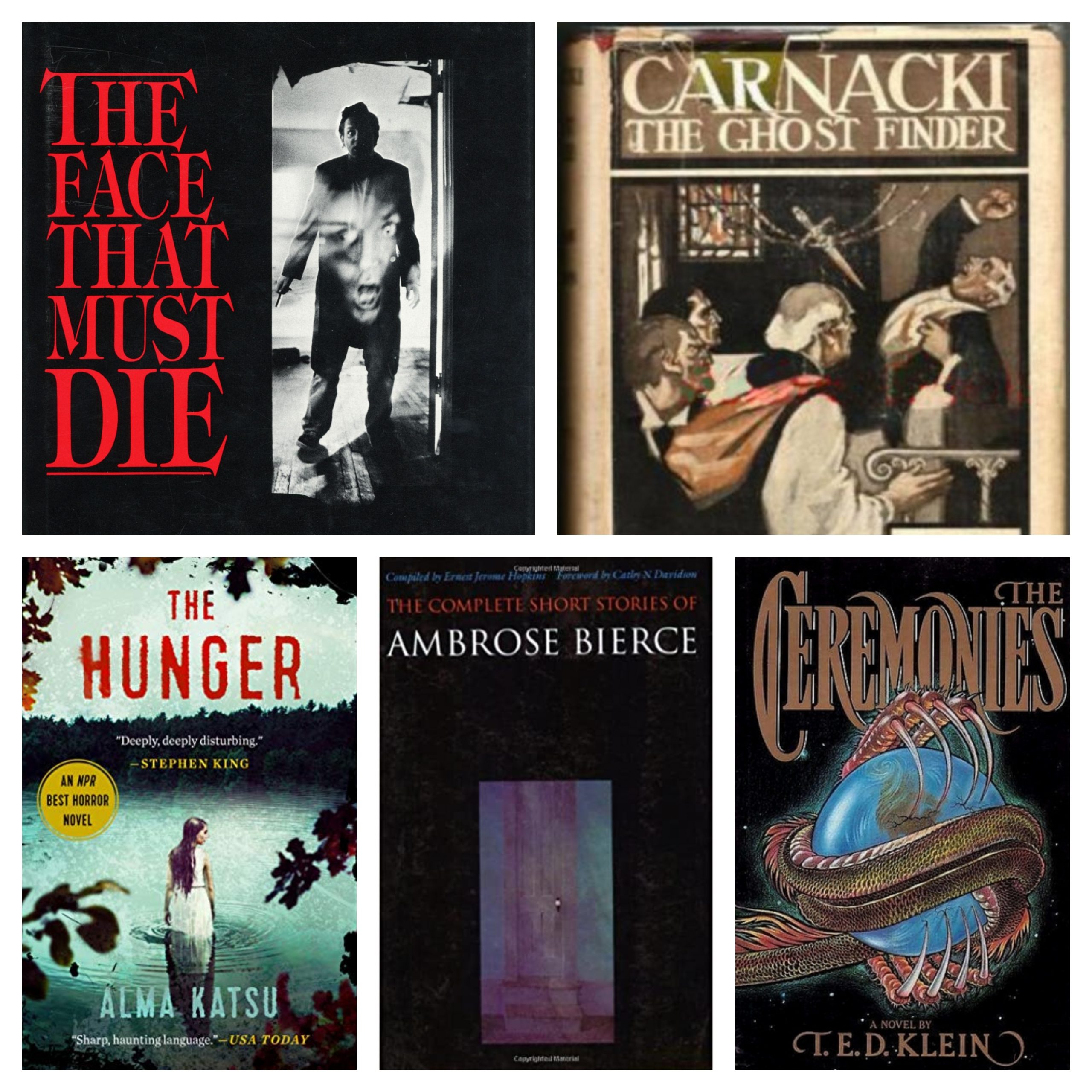In this entry, we return to the twisted world of Ramsey Campbell, check out supernatural detective adventures described by some as Sherlock Holmes Meets Scooby Doo, take a look at an alternate history of what REALLY killed the Donner party, read a wonderful collection of horror in the Civil War era and finally experience an epic slow burn folk horror masterpiece. High falutin’ words indeed!
For those just joining me, this is my journey through the following “Best of” Horror lists:
Reedsy Discovery Best Horror Books
Stephen Jones & Kim Newman’s Horror: 100 Best Books
Stephen Jones & Kim Newman Horror: Another 100 Books
If you want to check out my previous entries, they can be found here:
Part 23 | Part 22 | Part 21 | Part 20 | Part 19 | Part 18 | Part 17 | Part 16 | Part 15 | Part 14 | Part 13 | Part 12 | Part 11 | Part 10 | Part 9 | Part 8 | Part 7 | Part 6 |Part 5 | Part 4 | Part 3 | Part 2 | Part 1
Now let’s conjure up the spirits of old and allow our bodies to be sacrifice to the great Old Ones!
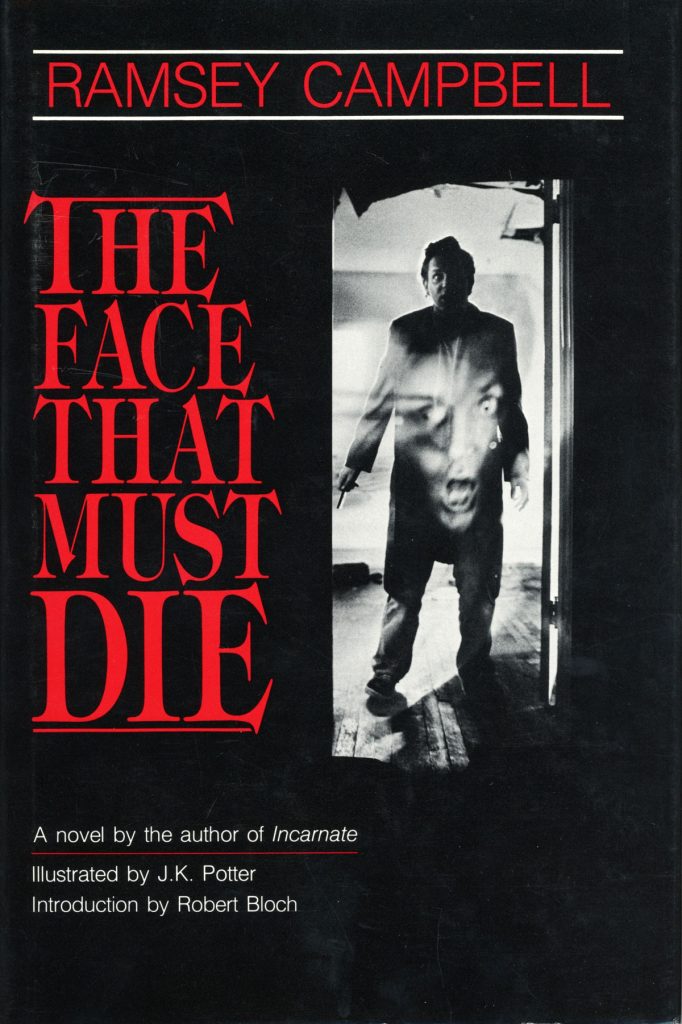
The Face That Must Die (Ramsey Campbell, 1982)
List: Jones/Newman
We follow an odd, withdrawn fellow with a limp named Horridge whose increasing paranoia begins to manifest in his obsession with a large effeminate man named Roy Craig who Horridge suspects of being a homosexual serial killer. Fortunately Horridge keeps his trusty razor blade close to him at all times to protect himself from the filth that surrounds him. So what if he were to lash out and dispose of some of this filth? He would be doing the world a favor, wouldn’t he? Horridge presents not only a danger to Roy Craig but the other denizens of Craig’s apartment complex like the budding artist Fanny and the disgruntled young married couple Carol and Peter.
Campbell really burrows deep into the mind of a truly sad and disturbed individual here. Horridge’s thoughts are manic and claustrophobic, and Campbell paints his increasingly irrational ideas and actions with a naturally excalating progression. You can see that the bridge is out from a long way away, but there just isn’t anything you can do to stop the train from careening off the tracks. Campbell does an excellent job of creating a Liverpool that Horridge can truly be terrified of in its mundane obscenities, it’s graffiti-laden overpasses and its regular people who seethe with hidden secrets of the vilest kind. Campbell thankfully makes the decision to not just keep us in the head of Horridge which could get to a be a bit much over the course of the novel if left entirely there. We also get to know Fanny, Craig and especially Carol and Peter. In a way, Carol’s and Peter’s insecure domestic squabbling, Carol’s insistence on moving into a house and starting a real family contrasted with Peter’s lack of ambition and habit of constantly getting stoned as a way of avoiding responsibility, is as unpleasant to endure as Horridge’s ravings because it just all feels so personal. I do feel Campbell gets a little distracted at time in describing locations and travel routes, similar to some of the issues I had with Fritz Leiber’s Our Lady of Darkness, which tends to diffuse the tension a little when I get two paragraphs going on about taking A street to B street, hopping on a bus, getting off at C street then turning left onto D street, etc. Still that’s a relatively minor complaint that isn’t going to be a dealbreaker for anyone looking to get into the mind of a truly disturbed individual.

Carnacki, the Ghost Finder (William Hope Hodgson, 1913)
List: Jones/Newman
Thomas Carnacki is a detective whose knowledge of the occult often entrenches him within strange and terrifying cases that seem supernatural in origin, often relying on an invention of his, the electric pentacle, to keep evil spirits at bay. From haunted rooms of houses creating sinister noises like blasts of whistling and bloody ceilings to a ghost horse to a haunting in his own childhood home, the stories of Carnacki generally begin with our narrator, a man named Dodgson, listening to Carnacki tell a tale of one of his seemingly paranormal experiences as part of an after-dinner storytelling club of sorts. Like Sherlock Holmes, Carnacki is a clinically-minded pragmatist with an eye for detail, going into each situation he is hired for with a skeptical mindset and with the burden of proof on the haunting. Interestingly enough, several of the stories do indeed end with the supernatural events being staged with wires, costumes and the like with Carnacki’s skepticism having proven correct. Some of the stories do have genuinely unexplainable phenomena that leaves Carnacki unable to logically explain the occurrence and in one instance even declaring that the offending room be burned to the ground.
Overall I quite liked these stories, described by some as Sherlock Holmes meets Scooby Doo, although of course that’s a highly reductive, if not at least a little bit true, statement. Hodgson also is a very good writer who is able to build suspense and convey the mindset of a cynic looking the seams while also being open to occult experiences. It’s a fine line to balance that could easily fall into self-parody but Hodgson handles it quite well. A couple of the stories feel a little same-y with similar structures and endings but overall this is a pretty solid collection if you read Sherlock Holmes and wished that sometimes the supernatural red herrings turned out to be true or if you like similar paranormal investigators like Algernon Blackwood’s John Silence (which I still need to read more of also).
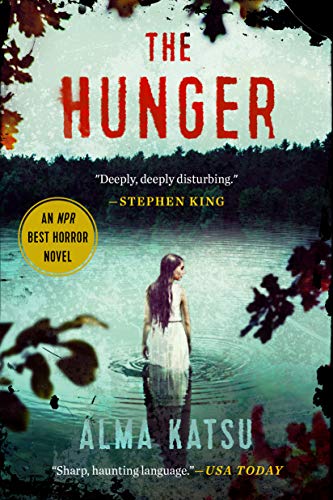
The Hunger (Alma Katsu, 2017)
Lists: NPR & Reedsy Discovery
The Hunger posits that the infamous Donner Party, who was thought to have become stranded in the Rockies during the winter while on the Oregon Trail and resorted to cannibalism, did not indeed merely succumb to the vagaries of a harsh winter and lack of food but instead met with something far more sinister out in the wilderness. We follow several different people in the party as they make their way westward and try to survive. Many of the people in the novel are based on real individuals who were on the wagon train (although I imagine great liberties were taken with their characterizations). There’s Tamsen Donner, strong-willed and mysterious wife of the leader of the party. There’s James Reed, Donner’s close confidant and the real decision maker who leads the party through the desert before being outed for hiding a socially unacceptable secret. There’s Mary Graves, unmarried and no-nonsense spinster who takes a shine to rough but keen journeyman Charles Stanton, who’s running from a dark secret of his own. There’s Lewis Keseberg, a vile but wily man who knows how to play his cards right to survive. These are only a handful of the many people we meet and grow to know through this perilous journey that will end with many dead and those that survive scarred by the endeavor.
The Donner Party is notorious for its cannibalistic exploits as the survivors neared starvation, but the reality is that cannibalism wasn’t totally unheard of during this time. As the book itself mentions, it wasn’t completely uncommon to hear of sailors out at sea who had to resort to devouring their fellow mates during times of extreme duress. Katsu could’ve played this one safe and given a more realistic account of grim survival and succumbing to the elements loosely based on how history played out. Instead, she injects an element of true horror into the mix with “the hunger” being not just an outcome of lack of provisions but spread like a plague causing those afflicted to become ravenous and start to change into something more feral. The book has an undercurrent of Native American mysticism and it doesn’t try to fully explain what exactly is happening while still giving enough information for the reader to piece together what’s happening. It actually reminded me a lot of Dan Simmons’ The Terror in overall structure and themes, following several different characters in a struggle for survival against the elements while haunted by more supernatural occurrences. The book is refreshingly unpredictable at times despite the story it’s based on, although it does feel a little messy narratively, jumping around to different people and with random flashbacks in places that can feel a little jarring. Overall, it’s a solid read though that could’ve been a little better with some tighter organization.
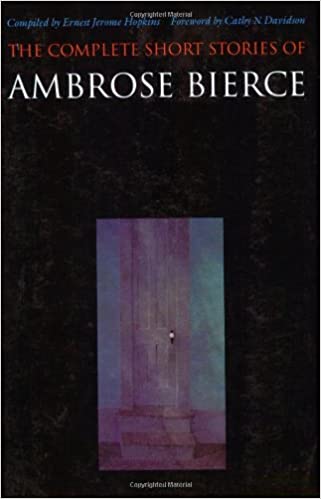
The Complete Short Stories of Ambrose Bierce (Ambrose Bierce, 1869-1909)
List: Jones/Newman
Where to even begin with this massive collection? Bierce was perhaps best known in his day as a masterful biting satirist who also happened to occasionally write some of the most violent, dark, witty short stories of the day. This collection segments his stories into essentially three loose themes: “The World of Horror”, The World of War” and “The World of Tall Tales’.
As one would expect from the title, Bierce’s supernatural output is collected in “The World of Horror”. This includes such well-regarded and frequently anthologies stories like “The Damned Thing”, “The Boarded Window”, “The Middle Toe of the Right Foot”, and the Robert W. Chambers and Lovecraft favorite “An Inhabitant at Carcosa”. His stories, whether supernatural or not tend to be very finely crafted, often with a kind of twist or sting at the end. In fact, the endings are often the strongest elements of his stories. He also keeps his short stories pretty short, with none of them long enough to take more than one sitting. Whether it be a story about a haunted house, an accursed pocket watch, a creepy road in the middle of the night, doppelgängers and other mysterious phenomena, Bierce uses very precisely worded and carefully crafted prose to cultivate an aura of the weird and unsettling. His stories are rarely outright terrifying but still often satisfying in and of themselves.
Another theme that Bierce was well-known for, captured in the section section of this collection under “The World of War”, was his penchant for setting stories during the Civil War. Many of these also had elements of the weird like his most famous story “An Occurrence at Owl Creel Bridge”, “Chickamauga” and “A Tough Tussle”. The latter two stories are also examples of how he used incredibly graphic and lurid descriptions of violence to convey the horrors of war. Some of his war stories were bitterly ironic military fiction like “Two Military Executions” and “One Officer, One Man” and while these wouldn’t fall under the umbrella of horror, they’re still generally well-written and engaging.
The third segment of this book and perhaps the most nebulous in theme is “The World of Tall Tales”. This section groups together some of Bierce’s most vile and absurdist fiction depicting characters that often come across as psychotic like the hilariously dark “My Favorite Murder”, the matter-of-fact parenticide of “An Imperfect Conflagration” and the supremely fucked up, even for today, “Oil of Dog”.
All in all, I enjoyed Bierce’s stuff immensely and while they aren’t 100% winners, his batting average is high enough to best most other writers of weird fiction out there.
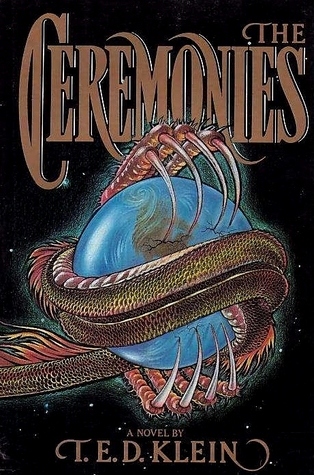
The Ceremonies (T.E.D. Klein, 1985)
List: Jones/Newman
Jeremy Friers is a college professor who takes sabbatical to work on some research on gothic literature. To let himself truly focus, he rents a room at a farm house in a remote religious community in New Jersey where many of the locals eye him with suspicion. Shortly before leaving for his summer long trip, he meets a shy waif of a young woman named Carol who aspires to be a dancer but spends much of her time working at a library as an assistant. They hit it off and despite a couple of false starts, Carol agrees to travel out and meet Jeremy at the Poroth Farm he’s staying at. What neither realizes is that another new acquaintance of Carol’s, an effeminate little old man nicknamed Rosie has been making plans, driving them all toward a fated convergence of evil in order to bring about the rise of the master.
Klein’s slow burn, atmospheric folk horror is a straight-up masterful book of creeping dread that really delivers on what it sets out to do. The character development is very good and even the Poroths are given a much more interesting, multi-layered arc that would’ve been left by the wayside in a lesser writer’s hands. Arthur Machen’s classic story “The White People” looms large over this work with that story providing much of the skeletal framework of this much larger tale. Klein is a notoriously unproductive writer with only a handful of short stories and this fairly lengthy novel to his credit which I have to say is a crying shame. His prose is practical yet imbued with a quiet menace that does such a good job of building suspense that you hardly notice when the point of no return has even arrived. It’s a book that sneaks up on you before laying you to rest and is a bona fide classic of ’80s horror fiction that you own it to yourself to read if you haven’t already.

